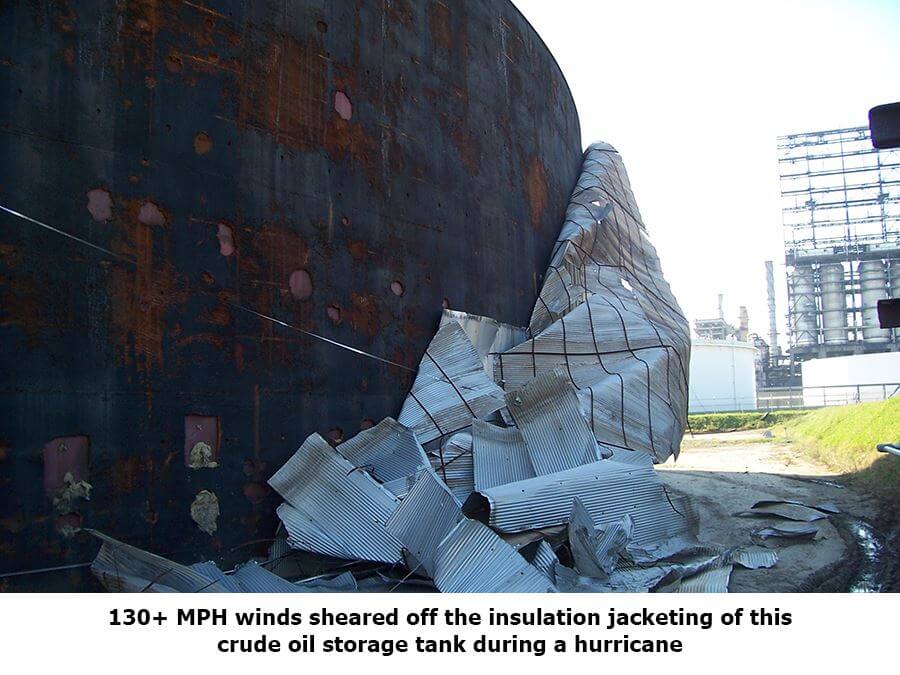Over many years of providing specifications and consultations to end users and engineering firms globally, we have found that there are optimal applications for all types of insulation materials. With this approach, one can recommend the best solution that meets the customer’s needs.
Thermal insulating coatings are an excellent option in areas prone to storms due to the many challenging factors those regions face. Problems like recurring severe weather events, high average rainfall totals and average to high humidity lead to escalating maintenance costs year after year. By using thermal insulating coatings, companies can have an insulation solution that is not affected by those issues, resulting in a lifelong return on investment.
Thermal insulating coatings have low thermal conductivity and create a barrier between a container or structure (e.g., pipelines, process vessels, tanks) and the surrounding environment, with the intention of reducing heat transfer. They also prevent the entry of moisture from the surroundings, prevent corrosion and protect personnel from extremely high or low temperatures. (For more on the benefits of insulating coatings, see Use of Insulating Coatings for Hazard Protection.) The coating is typically applied by airless spraying.
Threats Posed to Insulation by Tropical Storms and Hurricanes

An issue that affects facilities in these areas annually is the threat of superstorms and tropical events, i.e., tropical storms, depressions and hurricanes. Due to the installation nature of most conventional insulation systems, high winds and driving rain can be debilitating to the integrity of insulation in tank farms, refineries and other industrial facilities found the region. The high winds associated with these storms can severely damage, if not outright remove, the jacketing designed to hold and protect the traditional insulation material. Once damaged, the insulation material and substrate becomes even more exposed to the driving rains and high moisture environment.
Thermal Insulating Coatings Adhere Strongly to the Substrate
 Thermal insulating coatings adhere directly to the primed substrate such that it would require a very strong pull (on the order of +250 psi) to remove it from the surface. In terms of wind speed and psi, a 150 mph (241 km/h) wind has approximately 0.402 psi, so these coatings are very resistant to high winds. Damage from debris would be limited as well.
Thermal insulating coatings adhere directly to the primed substrate such that it would require a very strong pull (on the order of +250 psi) to remove it from the surface. In terms of wind speed and psi, a 150 mph (241 km/h) wind has approximately 0.402 psi, so these coatings are very resistant to high winds. Damage from debris would be limited as well.
Though this coating is pliable (as is a must when dealing with thermal expansion and contraction) and susceptible to mechanical damage, only the point of impact is affected, which is easily repaired, and moisture cannot spread further below the coating. (Learn more in the article Flexible Coatings for Protection of Marine Structures.) With something like mineral wool, a small damaged area can lead to wicking where moisture spreads from the point of impact to areas that appear unaffected.
Thermal Insulating Coatings Offer Better Thermal Efficiency
The moisture trapped in the insulation material will eventually lead to a significant corrosion under insulation (CUI) problem, which is a localized external corrosion that forms when water collects in insulation in the presence of oxygen. Additionally, the trapped moisture also causes an instant performance hit in the thermal properties of the product. (CUI is discussed in detail in the article Corrosion Under Insulation: The Challenge and Need for Insulation.)
When water is absorbed by conventional insulation systems, it reduces its overall effectiveness because moisture conducts heat more efficiently than air.
As shown in Table 1, a very small amount of moisture causes a significant drop in thermal efficiency. Also, as operating temperature increases, the negative effects of moisture increase as well. Things like molten sulfur, slurry and asphalt emulsions stored in the +200°F (+93°C) range will see a larger drop in thermal efficiency once moisture is added.

Table 1. Thermal efficiency of mineral wool at 160°F operating temperature.
Though thermal efficiency is lower (specifically at lower operating temperatures), the ability to have a consistent performance value for the life of the product and/or piece of equipment allows for peace of mind. Customers may benefit when provided with thermal analysis reports detailing the estimated thermal performance value specific to the customer’s parameters (i.e., ambient conditions, content temperature, wind, etc.).
Thermal Insulating Coatings Reduce the Risk of Corrosion Under Insulation (CUI)

The side effect of moisture is not only a reduced thermal performance value. Facilities around the world deal with corrosion under insulation, not just in the tropics. However, when you add these tropical events, it leads to a much higher potential for damage. By eliminating the ability for moisture to get behind the insulating material, a thermal insulating coating eliminates the risk of CUI.
There are some applications over 15 years old that show no signs of degradation (both thermally and mechanically). These thermal insulating coatings seamlessly bond to complex substrates with no need for complex geometrical fabrication for the extrusions, tank roof vents and supports that are typically the ingress points for moisture. Due to the wicking nature of products like mineral wool and calcium silicate mentioned earlier, these smaller entry points would ultimately affect a much larger area.

Conclusion
With the specific issues that the tropics face, thermal insulating coatings can help oil refineries, tank farms, sugar mills, paper mills and many of the other manufacturing facilities in this region with an insulation solution that actively protects a facility’s assets for many years to come.